S&P gave Tether the worst rating; which other stablecoins would it approve of?
Original article | Odaily Planet Daily ( @OdailyChina )
Author|Azuma ( @azuma_eth )
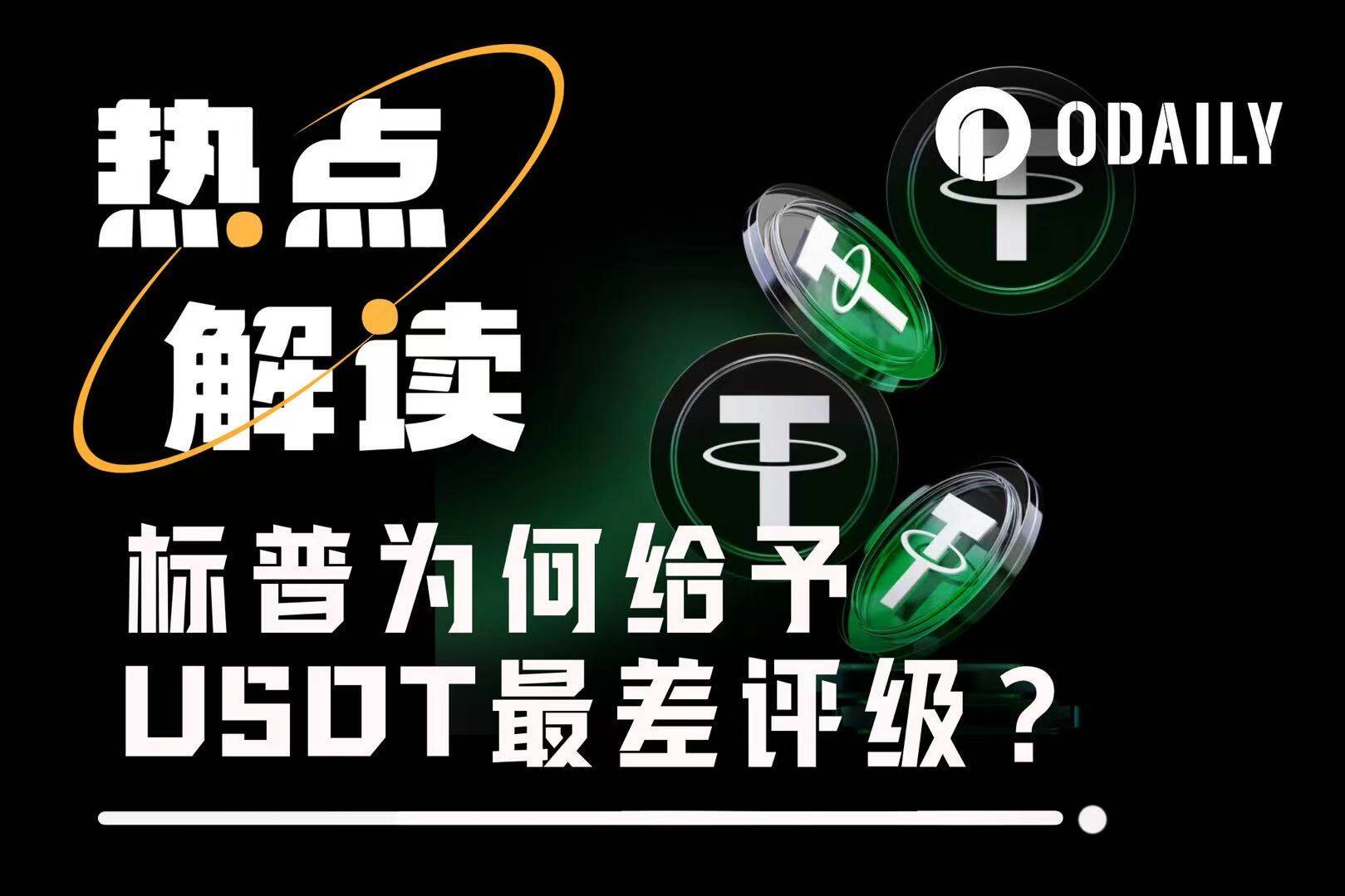
On November 26, Eastern Time, top rating agency S&P Global announced that it had downgraded the rating of stablecoin giant Tther (USDT) from "4" (restricted) to "5" (vulnerable), the lowest rating under the rating system.
This marks the second time S&P has given a surprisingly negative rating to an industry leader, following Strategy – see " S&P Gives Strategy a B- Rating, Why is the DAT Leader Considered Junk by Institutions? "
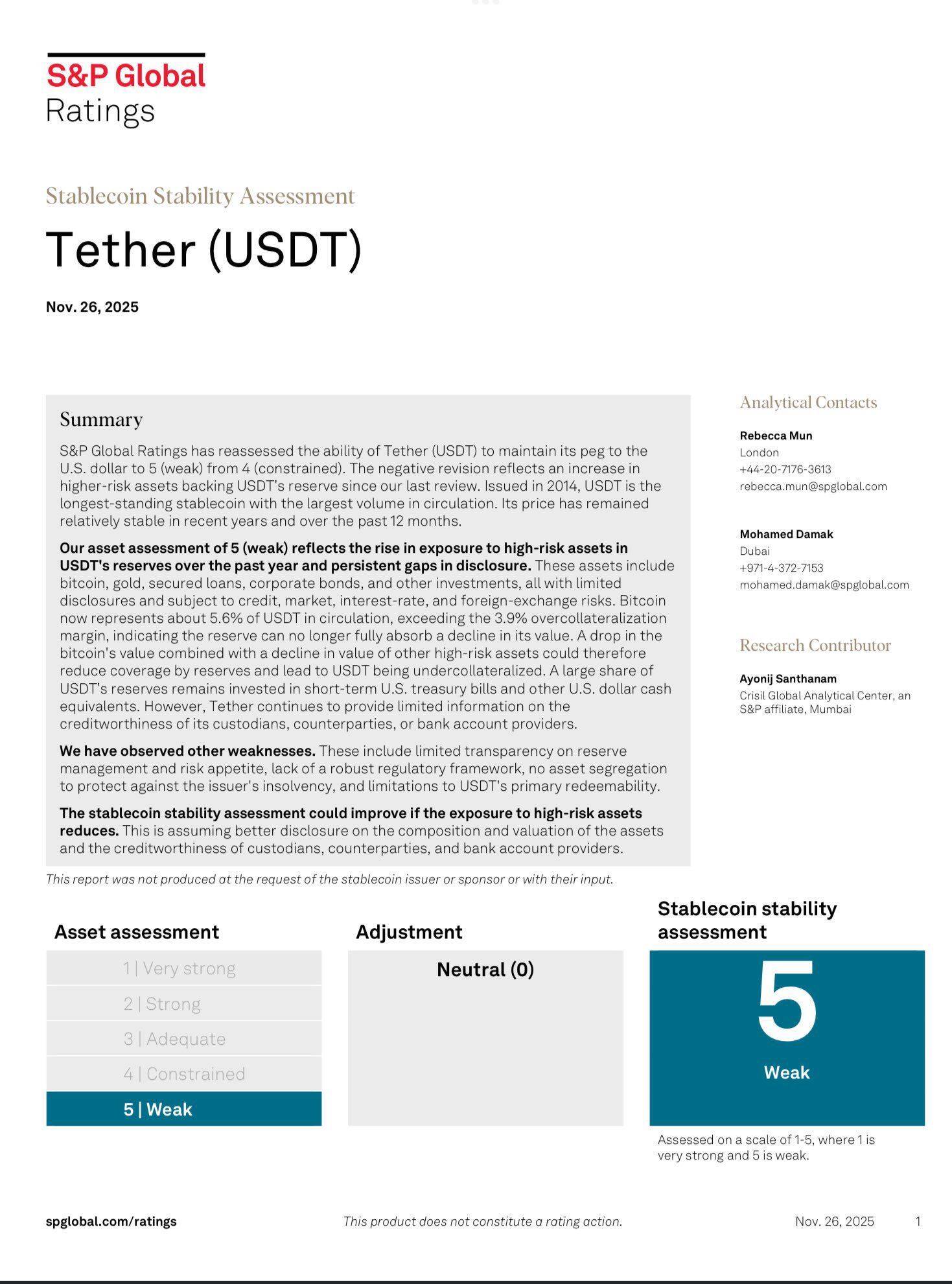
S&P's rating standards
Standard & Poor's (S&P), along with Moody's and Fitch, is considered one of the world's three major credit rating agencies and is widely recognized as one of the most authoritative credit rating agencies in the international financial market. According to S&P's official introduction, its stability assessment system for stablecoins aims to provide market participants with transparency regarding the stability of various stablecoins, and particularly delves into their decoupling risks.
Specifically, S&P's analysis method consists of the following steps:
- The first step is to conduct a risk assessment of asset quality, including credit risk, market value, and custody risk.
- The following analysis will further examine the extent to which the over-collateralization requirements and liquidation mechanisms of major stablecoins can mitigate these risks (light gray box in the image below).
- Taking all these factors into account, S&P will assign each stablecoin an asset quality score from 1 to 5 (extremely strong, strong, adequate, restricted, vulnerable) (black box in the image below).
- After completing the asset quality assessment, S&P will also consider five additional dimensions: governance mechanisms, legal and regulatory framework, redemption capacity and liquidity, technology and third-party dependence, and historical record (see dark gray box in the image below).
- The strengths and weaknesses of these five dimensions will together form an overall risk assessment view, thus affecting the final score of each stablecoin (red box in the figure below).
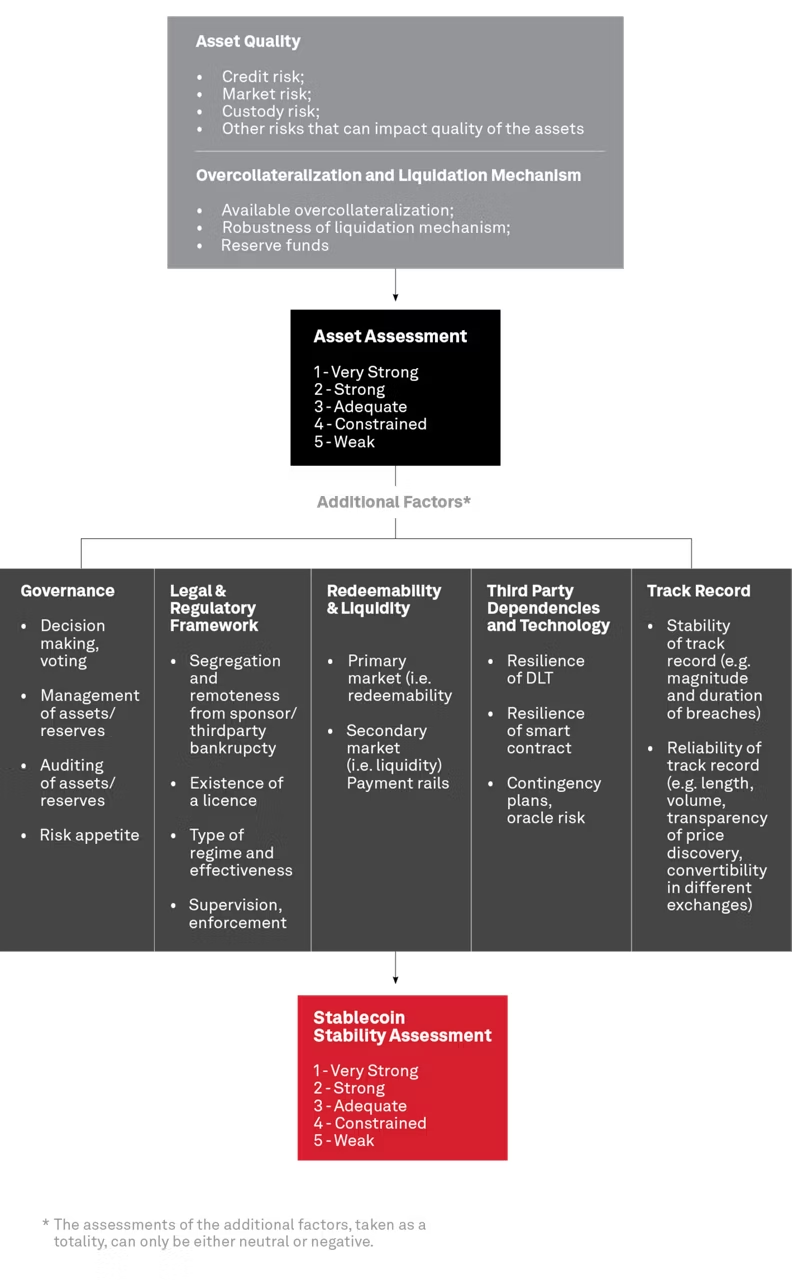
Reasons for rating Tether (USDT)
In its announcement regarding the downgrade of Tether (USDT), S&P stated that the reduction reflects the increase in high-risk assets in the reserves backing USDT since the last assessment, as well as ongoing issues with Tether's disclosure practices.
S&P explained that so-called high-risk assets include Bitcoin, gold, secured loans, corporate bonds, and other investments. All of these assets have limited information disclosure and face credit risk, market risk, interest rate risk, and foreign exchange risk. Currently, Tether's Bitcoin reserves account for approximately 5.6% of the total circulating supply of USDT, exceeding USDT's own over-collateralization ratio of 3.9%. This means that other low-risk reserve assets are insufficient to fully support the value of USDT. If the value of BTC and other high-risk assets declines, it could weaken the coverage of USDT reserves, leading to insufficient collateralization of USDT. As for other low-risk reserve assets, a large portion is invested in short-term US Treasury bonds and other dollar cash equivalents; however, Tether has consistently had disclosure issues regarding custodian institutions, counterparties, and bank account providers.
S&P added that, in addition to the main reasons mentioned above, the institution believes that Tether (USDT) also has other issues such as limited transparency in reserve management and risk appetite, lack of a sound regulatory framework, lack of asset segregation to prevent issuer bankruptcy, and limitations on USDT redeemability.
At the end of its rating assessment, S&P also added the possibility of a rating adjustment for Tether (USDT) – a reduction in USDT’s exposure to high-risk assets and improved disclosure by Tether could improve its assessment of stability.
Ratings of other stablecoins
Besides Tether, S&P has also rated several other major stablecoins, including USDC and USDe. The results are as follows:
- Circle (USDC): 2 (Strong);
- Circle (EURC): 2 (Strong);
- First Digital USD (FDUSD): 4 (Restricted);
- TrueUSD (TUSD): 5 (Vulnerable);
- Gemini USD (GUSD): 2 (Strong);
- Paxos USD (USDP): 2 (Strong);
- EUR Coinvertible (EURCv): 3 (sufficient);
- Mountain Protocol USD (USDM): 3 (sufficient);
- Ethena (USDe): 5 (Vulnerable);
- Sky Protocol (USDS/DAI): 4 (Restricted);
- Frax (FRAX): 5 (fragile);
As can be seen from the chart above, S&P clearly favors centralized stablecoins with overcollateralization models and higher transparency (such as USDC), while holding a relatively pessimistic attitude towards mainstream decentralized stablecoins (such as USDe and USDS). This is not hard to understand, as the rating logic in the first two parts shows that S&P classifies crypto assets such as BTC as high-risk, which is often the main collateral composition of decentralized stablecoins.
Tether's response
Following S&P's rating adjustment of Tether (USDT), Tether CEO Paolo Ardoino responded strongly on the X platform, saying, "We are proud of your hatred."
Paolo Ardoino added that the classical rating models used by traditional financial institutions have led countless private and institutional investors to invest in companies that, despite receiving investment-grade ratings, ultimately collapsed. This has prompted global regulators to question the independence and objectivity of these models and all major rating agencies. As companies attempt to break free from the shackles of the flawed financial system, the propaganda machine of traditional finance grows increasingly fearful. No company dares to attempt to escape this system. Against this backdrop, Tether has built the first financial industry company with surplus capital and no toxic asset reserves, and it remains highly profitable to this day. Tether's success demonstrates that the traditional financial system is riddled with problems, even frightening those "naked emperors."
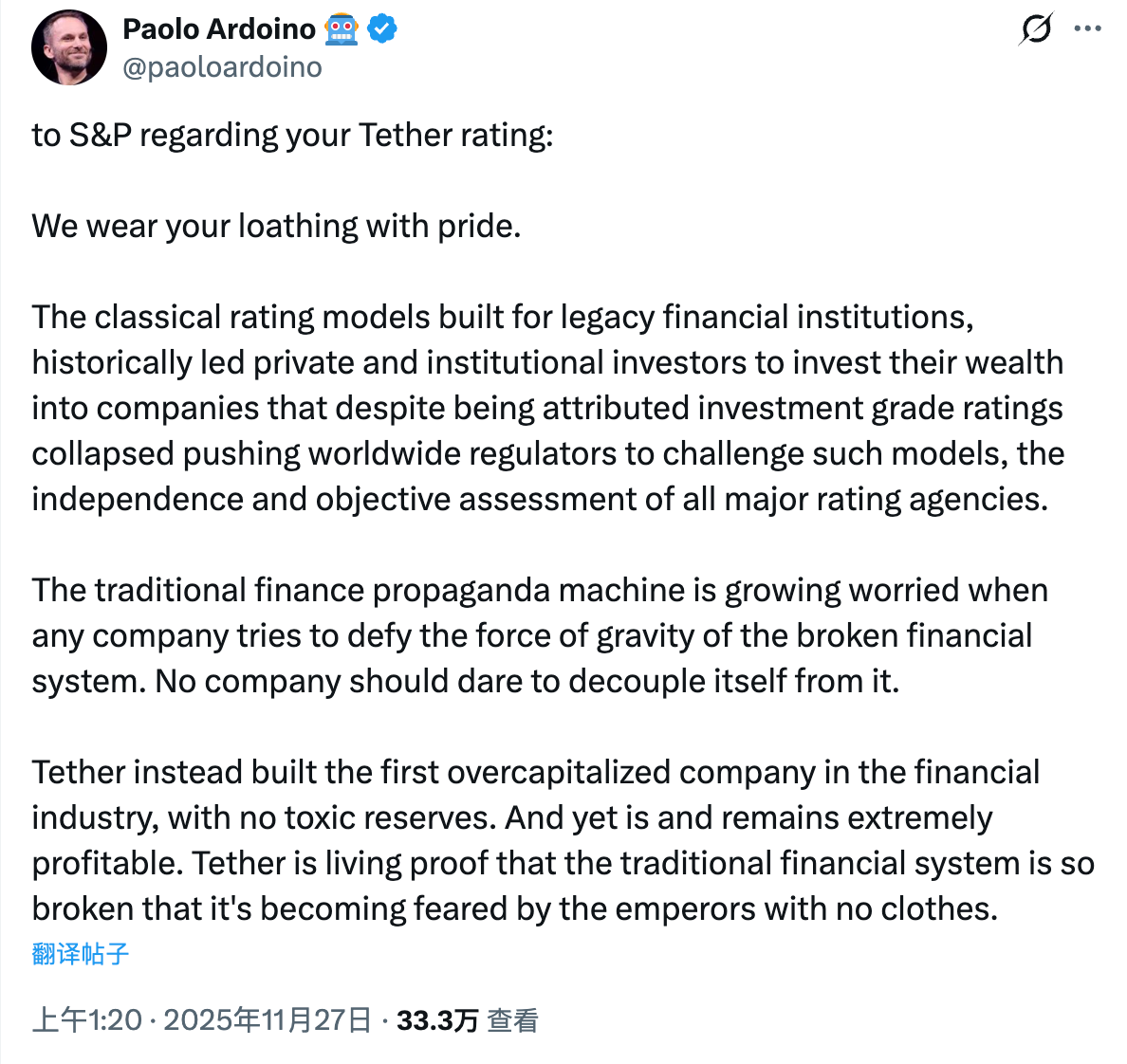
Will this have any impact on USDT?
Looking back at S&P's rating statement for Tether (USDT), in addition to the change in the proportion of BTC reserves, S&P repeatedly mentioned Tether's information disclosure issues.
Due to its offshore nature and some historical operational legacies, Tether has always been subject to some controversy regarding its transparency. Compared to its biggest competitor, USDC, USDT's insufficient disclosure in areas such as reserves and auditing is an objective fact. However, thanks to its unparalleled liquidity (especially since almost all CEXs use USDT as the basic settlement currency), coupled with its excellent historical performance and strong financial condition, the market still highly trusts and even relies on USDT— supported by a strong network effect, USDT has always firmly held the throne in the stablecoin race.
As overseas KOL Novacula Occami commented: "...Insufficient information disclosure is a long-standing problem for Tether, but they are neither able nor willing to solve it."
Clearly, S&P's stance alone is insufficient to shake USDT's market position. However, it's worth noting that Tether has officially announced the launch of its stablecoin, USAT, in the US market in December. The GENIUS Act, which includes strict regulations on reserve requirements, regulatory registration, disclosure mechanisms, and redemption terms, aligns closely with S&P's rating standards. Therefore, if Tether wants to successfully promote USAT in the US, it may need to consider S&P's rating to some extent.
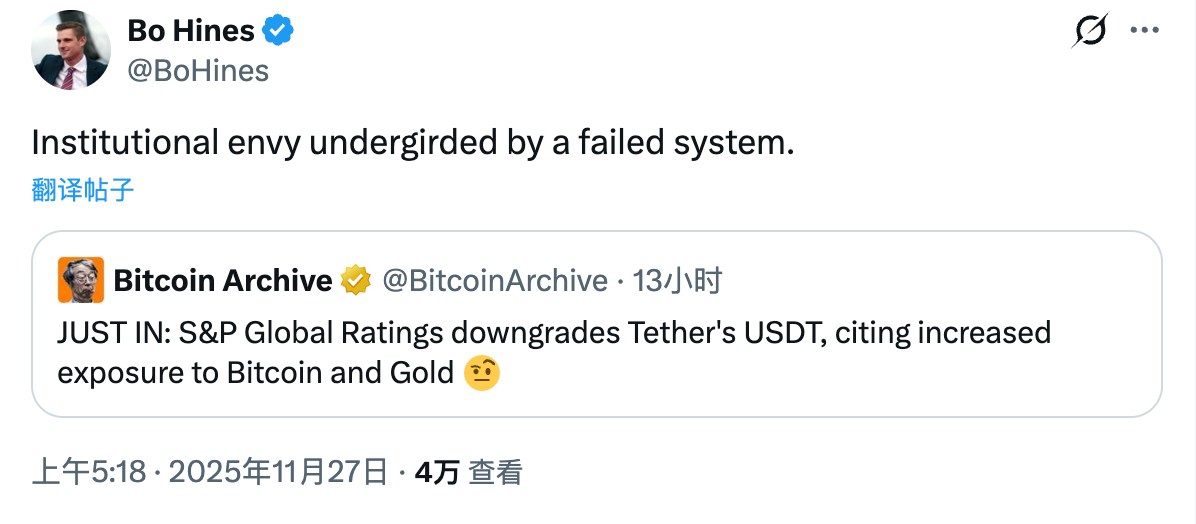
Today, following Paolo Ardoino's strong response to S&P, Bo Hines, head of Tether's USAT business, also joined in, vehemently criticizing "systemic enviousness stemming from institutional dysfunction." While Paolo Ardoino may not need to pay attention to S&P, Bo Hines really needs to think about how to specifically address the issues raised by S&P.
- 核心观点:标普将USDT评级下调至最低等级。
- 关键要素:
- 高风险资产占比上升,BTC储备超抵押率。
- 信息披露不足,储备透明度持续存疑。
- 缺乏健全监管框架与资产隔离机制。
- 市场影响:短期或引发信任波动,但难撼市场地位。
- 时效性标注:短期影响



